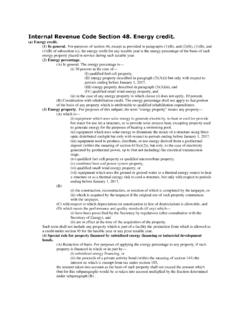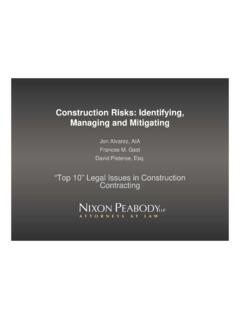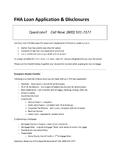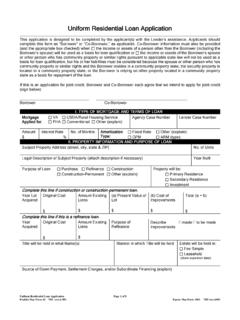Transcription of Tax-Exempt Housing Bond Basics - IPED - …
1 Simplified version for discussion purposes only. For answers to more complex questions, consult the 1 Low-Income Housing Tax Credit Handbook, visit , or call us at Tax-Exempt Housing bond Basics This handout contains excerpts from the LIHTC Basics workshop presented by Novogradac & Company LLP. Contact Wayne Michael at or for details on conducting an on-site workshop at your office. Some background on Tax-Exempt bonds States and local governments often finance public projects (like roads, prisons, schools, etc.) through the issuance of Tax-Exempt bonds tax exempt because the bond purchasers do not have to pay taxes on interest payments received.
2 Interest payments from bonds issued by private organizations for private activities, however, are generally taxable to bond purchasers. bond purchasers are generally willing to accept lower interest payments for Tax-Exempt bonds because of the tax savings. To promote certain private activities (which are deemed to benefit the public), each state is also authorized to allow the issuance of a set amount of private activity volume cap Tax-Exempt bonds (under IRC 142(d)).
3 The Tax-Exempt nature of the bonds makes them potentially as attractive to bond purchasers as bonds issued for public projects. Volume cap bonds can be allocated to finance multifamily Housing projects, single-family Housing , student loans, industrial development and other areas. In 2009, the amount of volume cap for each state is the greater of $90 per capita or $273,270,000. Projects that are financed (whether new construction or acquisition/rehab) in part by federal subsidies ( volume cap bonds) are eligible for 4% tax credits only.
4 Since the interest earned by the bondholders is tax exempt , the interest rate paid by the partnership is lower than non- Tax-Exempt bonds or conventional construction loans. Lower interest rates result in a higher loan amount as well. Projects financed by these Tax-Exempt bonds cannot be rewarded with lower interest payments AND 9% credits (which would be the best of both worlds), so they are simply ineligible for 9% credits. There is no limited pool for the 4% tax credit as there is for the 9% credits.
5 To obtain 4% tax credits, a partnership must first apply for an allocation of private activity bonds, which if received, leads to a non-competitive application process for the 4% tax credits. Simplified version for discussion purposes only. For answers to more complex questions, consult the 2 Low-Income Housing Tax Credit Handbook, visit , or call us at Bonds: The big picture When an operating partnership (the Borrower) needs to finance a LIHTC project using volume cap Tax-Exempt bonds, the partnership needs another entity to issue the bonds on its behalf.
6 So, the partnership approaches a potential Issuer (typically a city, or a county, or a Housing authority) to petition the state authority to issue a portion of the state s volume cap of Private Activity Bonds. A Regulatory Agreement between the Borrower and the Issuer establishes the Borrower s responsibilities regarding the rent and income restrictions and other aspects of leasing the apartment units. The Purchasers of the bonds are typically individuals or entities who simply want to make a good return on their investment.
7 They know nothing about the financial stability of the Borrower (or even who the Borrower is, for that matter). Executing a bond purchase agreement with the Issuer, the Underwriter markets the bonds to potential Purchasers and acts as a middleman between Purchasers and the other parties. The Underwriter will typically even advise the Borrower on selecting the appropriate Issuer and on the process for obtaining the volume cap bonds in the first place. Since no one is going to purchase the bonds based on the financial security of the Borrower, a financial institution with a superior credit rating ( AAA or Aaa ) steps in as a Credit Enhancer to guarantee that the Purchasers will receive a return of their capital as well as timely interest payments.
8 Simplified version for discussion purposes only. For answers to more complex questions, consult the 3 Low-Income Housing Tax Credit Handbook, visit , or call us at Confident in the AAA or Aaa rating attached to the bonds, the Purchasers buy the bonds through the Underwriter. The bond proceeds do NOT go directly to the Borrower, Issuer, or Underwriter but instead to a Trustee, where they are held in trust according to the provisions of a trust indenture, an agreement between the Trustee and the Issuer which outlines the terms for repayment of proceeds.
9 The Borrower enters into a mortgage note with a lender affiliated with the Credit Enhancer. If the Borrower defaults on the loan, the Credit Enhancer has claim to the project since the Credit Enhancer is still obligated to pay the Purchasers. Contractors and other service providers periodically submit invoices to the Borrower. Typically monthly, the Borrower aggregates the invoices, attaching them to a draw requisition for funds to be released to the service providers. As months pass, the proceeds are slowly depleted and eventually the Project is completed.
10 During this time, the Borrower continues to pay interest on the full value of the loan and will, at some point, be required to pay back the principal. The Underwriter, Credit Enhancer, and Trustee and each entity s respective legal counsel all work for a fee. The participation of so many fee-earning parties makes financing costs of Tax-Exempt bond deals incredibly high. The 2008 Housing and Economic Recovery Act (the 2008 Housing Act ) contains a provision that should help stretch the bond cap: recycling previously issued bonds.









